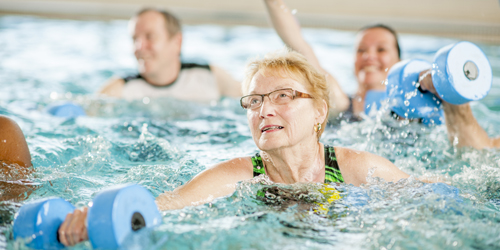
By Jenna Till, DPT, and Luke Iding, DPT
What does senescence mean to you? Have your heard the word sarcopenia? Both of these terms refer to the natural aging process.
As we age, many changes occur that can negatively impact the spine. Did you know that as your spinal discs shrink, your height may decrease up to two to three inches by the time you’re 70? Or that after age 30 you may lose 3 to 5 percent of your muscular mass with every passing decade?
So, with those dismal statistics in mind, how do we age gracefully? How can we combat these inevitable changes in our spine?
The best way is to keep moving! And there are so many safe ways to move. Healthy, low-impact activities range from walking, swimming, and biking to engaging in yoga, Pilates, or water aerobics.
Recent studies have shown that exercise programs that include a range of activity — aerobic, resistance, and flexibility exercises – can significantly reduce chronic low back pain as well as pain caused by osteoarthritis, fibromyalgia, and rheumatoid arthritis. In fact, when performed regularly, aerobic exercise may be as effective as anti-inflammatory NSAID medications for reducing pain.¹
In addition, physical activity can reduce your risk of developing chronic diseases such as hypertension, diabetes, stroke, and cancer. Movement helps improve your heart function as well. It is easy to forget that your heart is a muscle and that we must keep it strong!
Lastly, physical activity can promote healthy cognitive and psychosocial function.² For example, the Alzheimer’s Association notes that exercise boosts cognition and is especially helpful in reducing vascular dementia by increasing blood flow and oxygen to the brain.
In conclusion, the best thing we can do for our aging spine is to exercise. By committing to a lifetime of physical activity, we can reap the rewards of decreased pain, improved physical function, and an enhanced quality of life.
Jenna Till, DPT, and Luke Iding, DPT, are physical therapists at Mayfield Physical Therapy.
- Ambrose KR, Golightly YM. Physical exercise as non-pharmacological treatment of chronic pain: Why and when. Best Pract Res Clin Rheumatol. 2015;29(1):120–130. doi:10.1016/j.berh.2015.04.022 https://www.ncbi.nlm.nih.gov/pmc/articles/PMC4534717/
- James McKinney, MD, MSc,, Daniel J. Lithwick, MHA,, Barbara N. Morrison, BHK, Hamed Nazzari, MD, PhD,, Saul Isserow, MBBCh, Brett Heilbron, MB ChB,, Andrew D. Krahn, MD. The health benefits of physical activity and cardiorespiratory fitness. BCMJ, Vol. 58, No. 3, April, 2016, Page(s) 131-137 – Clinical Articles